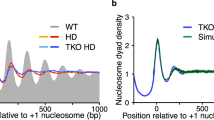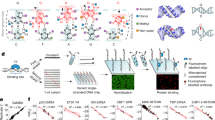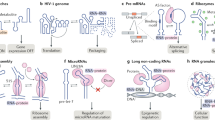Abstract
Transcriptional control requires the spatially and temporally coordinated action of many macromolecular complexes. Chromosomal proteins, transcription factors, co-activators and components of the general transcription machinery, including RNA polymerases, often use structurally or stoichiometrically ill-defined regions for interactions that convey regulatory information in processes ranging from chromatin remodeling to mRNA processing. Determining the functional significance of intrinsically disordered protein regions and developing conceptual models of their action will help to illuminate their key role in transcription regulation. Complexes comprising disordered regions often display short recognition elements embedded in flexible and sequentially variable environments that can lead to structural and functional malleability. This provides versatility to recognize multiple targets having different structures, facilitate conformational rearrangements and physically communicate with many partners in response to environmental changes. All these features expand the capacities of ordered complexes and give rise to efficient regulatory mechanisms.
This is a preview of subscription content, access via your institution
Access options
Subscribe to this journal
Receive 12 print issues and online access
$259.00 per year
only $21.58 per issue
Buy this article
- Purchase on Springer Link
- Instant access to full article PDF
Prices may be subject to local taxes which are calculated during checkout



Similar content being viewed by others
References
Sigler, P.B. Transcriptional activation. Acid blobs and negative noodles. Nature 333, 210–212 (1988).
Ansari, A.Z., Reece, R.J. & Ptashne, M. A transcriptional activating region with two contrasting modes of protein interaction. Proc. Natl. Acad. Sci. USA 95, 13543–13548 (1998).
Dunker, A.K., Obradovic, Z., Romero, P., Garner, E.C. & Brown, C.J. Intrinsic protein disorder in complete genomes. Genome Inform. Ser. Workshop Genome Inform. 11, 161–171 (2000).
Asturias, F.J. Another piece in the transcription initiation puzzle. Nat. Struct. Mol. Biol. 11, 1031–1033 (2004).
Romero, P. et al. Thousands of proteins likely to have long disordered regions. Pac. Symp. Biocomput. 3, 437–448 (1998).
Tompa, P. & Fuxreiter, M. Fuzzy complexes: polymorphism and structural disorder in protein-protein interactions. Trends Biochem. Sci. 33, 2–8 (2008).
Wright, P.E. & Dyson, H.J. Intrinsically unstructured proteins: re-assessing the protein structure-function paradigm. J. Mol. Biol. 293, 321–331 (1999).
Sickmeier, M. et al. DisProt: the database of disordered proteins. Nucleic Acids Res. 35, D786–D793 (2007).
Flaugh, S.L. & Lumb, K.J. Effects of macromolecular crowding on the intrinsically disordered proteins c-Fos and p27(Kip1). Biomacromolecules 2, 538–540 (2001).
McNulty, B.C., Young, G.B. & Pielak, G.J. Macromolecular crowding in the Escherichia coli periplasm maintains alpha-synuclein disorder. J. Mol. Biol. 355, 893–897 (2006).
Dyson, H.J. & Wright, P.E. Intrinsically unstructured proteins and their functions. Nat. Rev. Mol. Cell Biol. 6, 197–208 (2005).
Demarest, S.J. et al. Mutual synergistic folding in recruitment of CBP/p300 by p160 nuclear receptor coactivators. Nature 415, 549–553 (2002).
Uversky, V.N. Natively unfolded proteins: a point where biology waits for physics. Protein Sci. 11, 739–756 (2002).
Lacy, E.R. et al. p27 binds cyclin-CDK complexes through a sequential mechanism involving binding-induced protein folding. Nat. Struct. Mol. Biol. 11, 358–364 (2004).
Adams, V.H., McBryant, S.J., Wade, P.A., Woodcock, C.L. & Hansen, J.C. Intrinsic disorder and autonomous domain function in the multifunctional nuclear protein, MeCP2. J. Biol. Chem. 282, 15057–15064 (2007).
Uversky, V.N., Gillespie, J.R. & Fink, A.L. Why are “natively unfolded” proteins unstructured under physiologic conditions? Proteins 41, 415–427 (2000).
Tompa, P. Intrinsically unstructured proteins evolve by repeat expansion. Bioessays 25, 847–855 (2003).
Hansen, J.C., Lu, X., Ross, E.D. & Woody, R.W. Intrinsic protein disorder, amino acid composition, and histone terminal domains. J. Biol. Chem. 281, 1853–1856 (2006).
Dunker, A.K. et al. Protein disorder and the evolution of molecular recognition: theory, predictions and observations. Pac. Symp. Biocomput. 3, 473–484 (1998).
Tompa, P. Intrinsically unstructured proteins. Trends Biochem. Sci. 27, 527–533 (2002).
Tompa, P. The interplay between structure and function in intrinsically unstructured proteins. FEBS Lett. 579, 3346–3354 (2005).
Denning, D.P., Patel, S.S., Uversky, V., Fink, A.L. & Rexach, M. Disorder in the nuclear pore complex: the FG repeat regions of nucleoporins are natively unfolded. Proc. Natl. Acad. Sci. USA 100, 2450–2455 (2003).
Salghetti, S.E., Caudy, A.A., Chenoweth, J.G. & Tansey, W.P. Regulation of transcriptional activation domain function by ubiquitin. Science 293, 1651–1653 (2001).
Goodman, R.H. & Smolik, S. CBP/p300 in cell growth, transformation, and development. Genes Dev. 14, 1553–1577 (2000).
Tompa, P. & Csermely, P. The role of structural disorder in the function of RNA and protein chaperones. FASEB J. 18, 1169–1175 (2004).
Pierce, M.M., Baxa, U., Steven, A.C., Bax, A. & Wickner, R.B. Is the prion domain of soluble Ure2p unstructured? Biochemistry 44, 321–328 (2005).
Uversky, V.N., Oldfield, C.J. & Dunker, A.K. Showing your ID: intrinsic disorder as an ID for recognition, regulation and cell signaling. J. Mol. Recognit. 18, 343–384 (2005).
Dyson, H.J. & Wright, P.E. Coupling of folding and binding for unstructured proteins. Curr. Opin. Struct. Biol. 12, 54–60 (2002).
Fuxreiter, M., Simon, I., Friedrich, P. & Tompa, P. Preformed structural elements feature in partner recognition by intrinsically unstructured proteins. J. Mol. Biol. 338, 1015–1026 (2004).
Lee, H. et al. Local structural elements in the mostly unstructured transcriptional activation domain of human p53. J. Biol. Chem. 275, 29426–29432 (2000).
Oldfield, C.J. et al. Coupled folding and binding with alpha-helix-forming molecular recognition elements. Biochemistry 44, 12454–12470 (2005).
Csizmok, V. et al. Primary contact sites in intrinsically unstructured proteins: the case of calpastatin and microtubule-associated protein 2. Biochemistry 44, 3955–3964 (2005).
Neduva, V. & Russell, R.B. Linear motifs: evolutionary interaction switches. FEBS Lett. 579, 3342–3345 (2005).
Fuxreiter, M., Tompa, P. & Simon, I. Local structural disorder imparts plasticity on linear motifs. Bioinformatics 23, 950–956 (2007).
Iakoucheva, L.M. et al. The importance of intrinsic disorder for protein phosphorylation. Nucleic Acids Res. 32, 1037–1049 (2004).
Cox, C.J. et al. The regions of securin and cyclin B proteins recognized by the ubiquitination machinery are natively unfolded. FEBS Lett. 527, 303–308 (2002).
Shoemaker, B.A., Portman, J.J. & Wolynes, P.G. Speeding molecular recognition by using the folding funnel: the fly-casting mechanism. Proc. Natl. Acad. Sci. USA 97, 8868–8873 (2000).
Oldfield, C.J. et al. Flexible nets: disorder and induced fit in the associations of p53 and 14–3-3 with their partners. BMC Genomics 9 (suppl. 1), S1 (2008).
Tompa, P., Szasz, C. & Buday, L. Structural disorder throws new light on moonlighting. Trends Biochem. Sci. 30, 484–489 (2005).
Reeves, R. & Beckerbauer, L. HMGI/Y proteins: flexible regulators of transcription and chromatin structure. Biochim. Biophys. Acta 1519, 13–29 (2001).
Nash, P. et al. Multisite phosphorylation of a CDK inhibitor sets a threshold for the onset of DNA replication. Nature 414, 514–521 (2001).
Tjian, R. & Maniatis, T. Transcriptional activation: a complex puzzle with few easy pieces. Cell 77, 5–8 (1994).
Davis, J.A., Takagi, Y., Kornberg, R.D. & Asturias, F.A. Structure of the yeast RNA polymerase II holoenzyme: mediator conformation and polymerase interaction. Mol. Cell 10, 409–415 (2002).
Kostek, S.A. et al. Molecular architecture and conformational flexibility of human RNA polymerase II. Structure 14, 1691–1700 (2006).
Hansen, J.C. Conformational dynamics of the chromatin fiber in solution: determinants, mechanisms and functions. Annu. Rev. Biophys. Biomol. Struct. 31, 361–392 (2002).
Luger, K., Mader, A.W., Richmond, R.K., Sargent, D.F. & Richmond, T.J. Crystal structure of the nucleosome core particle at 2.8 A resolution. Nature 389, 251–260 (1997).
Hansen, J.C., Tse, C. & Wolffe, A.P. Structure and function of the core histone N-termini: more than meets the eye. Biochemistry 37, 17637–17641 (1998).
Ruthenburg, A.J., Li, H., Patel, D.J. & Allis, C.D. Multivalent engagement of chromatin modifications by linked binding modules. Nat. Rev. Mol. Cell Biol. 8, 983–994 (2007).
Clapier, C.R., Langst, G., Corona, D.F., Becker, P.B. & Nightingale, K.P. Critical role for the histone H4 N terminus in nucleosome remodeling by ISWI. Mol. Cell. Biol. 21, 875–883 (2001).
Xiao, H. et al. Dual functions of largest NURF subunit NURF301 in nucleosome sliding and transcription factor interactions. Mol. Cell 8, 531–543 (2001).
Fazzio, T.G., Gelbart, M.E. & Tsukiyama, T. Two distinct mechanisms of chromatin interaction by the Isw2 chromatin remodeling complex in vivo. Mol. Cell. Biol. 25, 9165–9174 (2005).
Ferreira, H., Flaus, A. & Owen-Hughes, T. Histone modifications influence the action of Snf2 family remodelling enzymes by different mechanisms. J. Mol. Biol. 374, 563–579 (2007).
Jenuwein, T. & Allis, C.D. Translating the histone code. Science 293, 1074–1080 (2001).
Baneres, J.L., Martin, A. & Parello, J. The N tails of histones H3 and H4 adopt a highly structured conformation in the nucleosome. J. Mol. Biol. 273, 503–508 (1997).
Hartlepp, K.F. et al. The histone fold subunits of Drosophila CHRAC facilitate nucleosome sliding through dynamic DNA interactions. Mol. Cell. Biol. 25, 9886–9896 (2005).
Hamiche, A., Kang, J.G., Dennis, C., Xiao, H. & Wu, C. Histone tails modulate nucleosome mobility and regulate ATP-dependent nucleosome sliding by NURF. Proc. Natl. Acad. Sci. USA 98, 14316–14321 (2001).
Smith, C.L., Horowitz-Scherer, R., Flanagan, J.F., Woodcock, C.L. & Peterson, C.L. Structural analysis of the yeast SWI/SNF chromatin remodeling complex. Nat. Struct. Biol. 10, 141–145 (2003).
Wu, P.Y., Ruhlmann, C., Winston, F. & Schultz, P. Molecular architecture of the S. cerevisiae SAGA complex. Mol. Cell 15, 199–208 (2004).
Huth, J.R. et al. The solution structure of an HMG-I(Y)-DNA complex defines a new architectural minor groove binding motif. Nat. Struct. Biol. 4, 657–665 (1997).
Liu, J. et al. Intrinsic disorder in transcription factors. Biochemistry 45, 6873–6888 (2006).
Hope, I.A., Mahadevan, S. & Struhl, K. Structural and functional characterization of the short acidic transcriptional activation region of yeast GCN4 protein. Nature 333, 635–640 (1988).
Cress, W.D. & Triezenberg, S.J. Critical structural elements of the VP16 transcriptional activation domain. Science 251, 87–90 (1991).
Drysdale, C.M. et al. The transcriptional activator GCN4 contains multiple activation domains that are critically dependent on hydrophobic amino acids. Mol. Cell. Biol. 15, 1220–1233 (1995).
Ng, K.P. et al. Multiple aromatic side chains within a disordered structure are critical for transcription and transforming activity of EWS family oncoproteins. Proc. Natl. Acad. Sci. USA 104, 479–484 (2007).
Sugase, K., Dyson, H.J. & Wright, P.E. Mechanism of coupled folding and binding of an intrinsically disordered protein. Nature 447, 1021–1025 (2007).
Ferreira, M.E. et al. Mechanism of transcription factor recruitment by acidic activators. J. Biol. Chem. 280, 21779–21784 (2005).
Zitzewitz, J.A., Ibarra-Molero, B., Fishel, D.R., Terry, K.L. & Matthews, C.R. Preformed secondary structure drives the association reaction of GCN4-p1, a model coiled-coil system. J. Mol. Biol. 296, 1105–1116 (2000).
Spolar, R.S. & Record, M.T. Jr. Coupling of local folding to site-specific binding of proteins to DNA. Science 263, 777–784 (1994); comment 263, 769–770 (1994).
Dames, S.A., Martinez-Yamout, M., De Guzman, R.N., Dyson, H.J. & Wright, P.E. Structural basis for Hif-1 alpha /CBP recognition in the cellular hypoxic response. Proc. Natl. Acad. Sci. USA 99, 5271–5276 (2002).
De Guzman, R.N., Martinez-Yamout, M.A., Dyson, H.J. & Wright, P.E. Interaction of the TAZ1 domain of the CREB-binding protein with the activation domain of CITED2: regulation by competition between intrinsically unstructured ligands for non-identical binding sites. J. Biol. Chem. 279, 3042–3049 (2004).
Mujtaba, S. et al. Structural mechanism of the bromodomain of the coactivator CBP in p53 transcriptional activation. Mol. Cell 13, 251–263 (2004).
Radhakrishnan, I. et al. Solution structure of the KIX domain of CBP bound to the transactivation domain of CREB: a model for activator:coactivator interactions. Cell 91, 741–752 (1997).
Heery, D.M., Kalkhoven, E., Hoare, S. & Parker, M.G. A signature motif in transcriptional co-activators mediates binding to nuclear receptors. Nature 387, 733–736 (1997).
Girdwood, D. et al. P300 transcriptional repression is mediated by SUMO modification. Mol. Cell 11, 1043–1054 (2003).
Black, J.C., Choi, J.E., Lombardo, S.R. & Carey, M. A mechanism for coordinating chromatin modification and preinitiation complex assembly. Mol. Cell 23, 809–818 (2006).
Kornberg, R.D. Mediator and the mechanism of transcriptional activation. Trends Biochem. Sci. 30, 235–239 (2005).
Thompson, P.R. et al. Regulation of the p300 HAT domain via a novel activation loop. Nat. Struct. Mol. Biol. 11, 308–315 (2004).
Myers, L.C., Gustafsson, C.M., Hayashibara, K.C., Brown, P.O. & Kornberg, R.D. Mediator protein mutations that selectively abolish activated transcription. Proc. Natl. Acad. Sci. USA 96, 67–72 (1999).
Asturias, F.J., Jiang, Y.W., Myers, L.C., Gustafsson, C.M. & Kornberg, R.D. Conserved structures of mediator and RNA polymerase II holoenzyme. Science 283, 985–987 (1999).
Taatjes, D.J., Naar, A.M., Andel, F. III, Nogales, E. & Tjian, R. Structure, function, and activator-induced conformations of the CRSP coactivator. Science 295, 1058–1062 (2002).
Taatjes, D.J., Schneider-Poetsch, T. & Tjian, R. Distinct conformational states of nuclear receptor-bound CRSP-Med complexes. Nat. Struct. Mol. Biol. 11, 664–671 (2004).
Chadick, J.Z. & Asturias, F.J. Structure of eukaryotic Mediator complexes. Trends Biochem. Sci. 30, 264–271 (2005).
Elmlund, H. et al. The cyclin-dependent kinase 8 module sterically blocks Mediator interactions with RNA polymerase II. Proc. Natl. Acad. Sci. USA 103, 15788–15793 (2006).
Tóth-Petróczy, A. et al. Malleable machines in transcription regulation: the Mediator complex. PLoS Comput. Biol. (in the press).
Takagi, Y. et al. Head module control of mediator interactions. Mol. Cell 23, 355–364 (2006).
Lariviere, L. et al. Structure and TBP binding of the Mediator head subcomplex Med8-Med18-Med20. Nat. Struct. Mol. Biol. 13, 895–901 (2006).
van de Peppel, J. et al. Mediator expression profiling epistasis reveals a signal transduction pathway with antagonistic submodules and highly specific downstream targets. Mol. Cell 19, 511–522 (2005).
Corden, J.L. Tails of RNA polymerase II. Trends Biochem. Sci. 15, 383–387 (1990).
Proudfoot, N.J., Furger, A. & Dye, M.J. Integrating mRNA processing with transcription. Cell 108, 501–512 (2002).
Fabrega, C., Shen, V., Shuman, S. & Lima, C.D. Structure of an mRNA capping enzyme bound to the phosphorylated carboxy-terminal domain of RNA polymerase II. Mol. Cell 11, 1549–1561 (2003).
Bushnell, D.A., Westover, K.D., Davis, R.E. & Kornberg, R.D. Structural basis of transcription: an RNA polymerase II-TFIIB cocrystal at 4.5 Angstroms. Science 303, 983–988 (2004).
Chen, H.T. & Hahn, S. Mapping the location of TFIIB within the RNA polymerase II transcription preinitiation complex: a model for the structure of the PIC. Cell 119, 169–180 (2004).
Chung, W.H. et al. RNA polymerase II/TFIIF structure and conserved organization of the initiation complex. Mol. Cell 12, 1003–1013 (2003).
Yong, C. et al. Structure of the human transcription factor TFIIF revealed by limited proteolysis with trypsin. FEBS Lett. 435, 191–194 (1998).
Brown, C.J. et al. Evolutionary rate heterogeneity in proteins with long disordered regions. J. Mol. Evol. 55, 104–110 (2002).
Zor, T., De Guzman, R.N., Dyson, H.J. & Wright, P.E. Solution structure of the KIX domain of CBP bound to the transactivation domain of c-Myb. J. Mol. Biol. 337, 521–534 (2004).
Lu, X. & Hansen, J.C. Identification of specific functional subdomains within the linker histone H10 C-terminal domain. J. Biol. Chem. 279, 8701–8707 (2004).
McBryant, S.J., Krause, C. & Hansen, J.C. Domain organization and quaternary structure of the Saccharomyces cerevisiae silent information regulator 3 protein, Sir3p. Biochemistry 45, 15941–15948 (2006).
Szollosi, E. et al. Intrinsic structural disorder of DF31, a Drosophila protein of chromatin decondensation and remodeling activities. J. Proteome Res. 7, 2291–2299 (2008).
Radhakrishnan, I., Perez-Alvarado, G.C., Dyson, H.J. & Wright, P.E. Conformational preferences in the Ser133-phosphorylated and non-phosphorylated forms of the kinase inducible transactivation domain of CREB. FEBS Lett. 430, 317–322 (1998).
Hon, W.C. et al. Structural basis for the recognition of hydroxyproline in HIF-1 alpha by pVHL. Nature 417, 975–978 (2002).
Cramer, P. et al. Architecture of RNA polymerase II and implications for the transcription mechanism. Science 288, 640–649 (2000).
Acknowledgements
M.F. is supported by MRTN-CT-2005-019566 of the European FP6 and by the Bolyai János fellowship; P.T. is supported by Országos Tudományos Kutatási Alapprogramok NK 71582, ETT 245/2006; and I.S. is supported by Országos Tudományos Kutatási Alapprogramok K72569. V.N.U. is supported by the grants R01 LM007688-01A1 (to A.K. Dunker and V.N.U.) and GM071714-01A2 (to A.K. Dunker and V.N.U.) from the US National Institutes of Health. We gratefully acknowledge the support of the Indiana University, Purdue University at Indianapolis Signature Centers Initiative. J.C.H. is supported by US National Institutes of Health grants GM45916 and GM66834. F.J.A. is supported by funds from the US National Institute of General Medical Sciences and the Leukemia and Lymphoma Society of America. The authors are grateful to C. Oldfield for his contribution to Figure 2.
Author information
Authors and Affiliations
Corresponding author
Rights and permissions
About this article
Cite this article
Fuxreiter, M., Tompa, P., Simon, I. et al. Malleable machines take shape in eukaryotic transcriptional regulation. Nat Chem Biol 4, 728–737 (2008). https://doi.org/10.1038/nchembio.127
Published:
Issue Date:
DOI: https://doi.org/10.1038/nchembio.127



